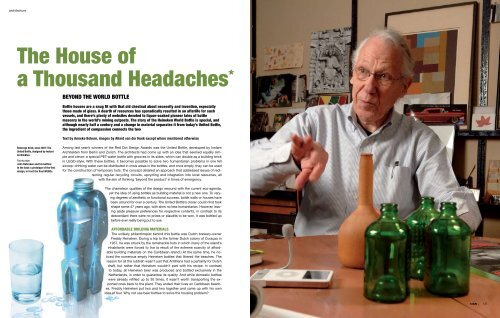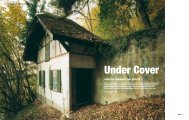The House of a Thousand Headaches* - ANNEKE BOKERN
The House of a Thousand Headaches* - ANNEKE BOKERN
The House of a Thousand Headaches* - ANNEKE BOKERN
Create successful ePaper yourself
Turn your PDF publications into a flip-book with our unique Google optimized e-Paper software.
architecture<br />
<strong>The</strong> <strong>House</strong> <strong>of</strong><br />
a <strong>Thousand</strong> Headaches *<br />
BEYOND THE WORLD BOTTLE<br />
Bottle houses are a snug fit with that old chestnut about necessity and invention, especially<br />
those made <strong>of</strong> glass. A dearth <strong>of</strong> resources has sporadically resulted in an afterlife for such<br />
vessels, and there’s plenty <strong>of</strong> websites devoted to liquor-soaked pioneer tales <strong>of</strong> bottle<br />
masonry in the world’s mining outposts. <strong>The</strong> story <strong>of</strong> the Heineken World Bottle is special, and<br />
although nearly half a century and a change in material separates it from today’s United Bottle,<br />
the ingredient <strong>of</strong> compassion connects the two<br />
Text by Anneke Bokern, images by Allard van der Hoek except where mentioned otherwise<br />
Beverage brick, anno 2007: <strong>The</strong><br />
United Bottle, designed by Instant<br />
Architekten.<br />
Facing page:<br />
John Habraken and his bottles:<br />
In the back a prototype <strong>of</strong> the first<br />
design, in front the final WOBOs.<br />
Among last year’s winners <strong>of</strong> the Red Dot Design Awards was the United Bottle, developed by Instant<br />
Architekten from Berlin and Zurich. <strong>The</strong> architects had come up with an idea that seemed equally simple<br />
and clever: a special PET-water bottle with grooves in its sides, which can double as a building brick<br />
in LEGO-style. With these bottles, it becomes possible to solve two humanitarian problems in one fell<br />
swoop: drinking water can be distributed in crisis areas in the bottles, and once empty, they can be used<br />
for the construction <strong>of</strong> temporary huts. <strong>The</strong> concept detailed an approach that addressed issues <strong>of</strong> redirecting<br />
regular recycling circuits, upcycling and integration into local resources, all<br />
with the aim <strong>of</strong> thinking ‘beyond the product’ in times <strong>of</strong> emergency.<br />
<strong>The</strong> chameleon qualities <strong>of</strong> the design resound with the current eco-agenda,<br />
yet the idea <strong>of</strong> using bottles as building material is not a new one. To varying<br />
degrees <strong>of</strong> aesthetic or functional success, bottle walls or houses have<br />
been around for over a century. <strong>The</strong> United Bottle’s closer cousin first took<br />
shape some 47 years ago, with aims no less humanitarian. However, leaving<br />
aside pleasure preferences for respective contents, in contrast to its<br />
descendant there were no prizes or plaudits to be won. It was bottled up<br />
before ever really being put to use.<br />
AFFORDABLE BUILDING MATERIALS<br />
<strong>The</strong> unlikely philanthropist behind this bottle was Dutch brewery-owner<br />
Freddy Heineken. During a trip to the former Dutch colony <strong>of</strong> Curaçao in<br />
1957, he was struck by the ramshackle huts in which many <strong>of</strong> the island’s<br />
inhabitants were forced to live (a result <strong>of</strong> the extreme scarcity <strong>of</strong> affordable<br />
building materials on the Caribbean island.) At the same time, he noticed<br />
the numerous empty Heineken bottles that littered the beaches. <strong>The</strong><br />
reason for all the rubbish wasn’t just that Antillians had a partiality for Dutch<br />
draft, but rather that Heineken wouldn’t part with his recipe: in contrast<br />
to today, all Heineken beer was produced and bottled exclusively in the<br />
Netherlands, in order to guarantee its quality. And while domestic bottles<br />
were already refilled up to 30 times, it wasn’t worth transporting the exported<br />
ones back to the plant. <strong>The</strong>y ended their lives on Caribbean beaches.<br />
Freddy Heineken put two and two together and came up with his own<br />
idea <strong>of</strong> four. Why not use beer bottles to solve the housing problem?<br />
136 137
design<br />
Above, left:<br />
A hut constructed from United<br />
Bottles was presented at the Design<br />
Annual 2007 in Frankfurt.<br />
Photo: Messe Frankfurt/Constantin<br />
Meyer/Cologne<br />
Top, middle:<br />
Not macho enough: <strong>The</strong> first,<br />
rejected design for the Heineken<br />
beer brick resembled a Chiantibottle.<br />
Top, right:<br />
<strong>The</strong> only building ever constructed<br />
from WOBOs was a simple bottle<br />
hut on Heineken’s estate in the<br />
Netherlands.<br />
Above, right:<br />
Getting a grip: the WOBO was short<br />
and sturdy, with an indentation in<br />
its base for the next bottle neck,<br />
and little dots on its sides for better<br />
grip.<br />
One might assume that beer has helped more people lose their homes than build them, but Heineken<br />
was serious. Back in the Netherlands, he started to look for a designer who could devise a new kind <strong>of</strong><br />
beer bottle. He mentioned this during a business lunch with one <strong>of</strong> his lawyers, and as it turned out, this<br />
lawyer happened to be the uncle <strong>of</strong> a promising young architect from Delft called John Habraken. ‘He<br />
told Heineken that I might be mad enough to go for it,’ remembers Habraken, now a fit-as-a-fiddle octogenarian.<br />
‘And he was perfectly right.’<br />
BUTCH BEER BOTTLE<br />
Mad or not, soon afterwards Habraken set about designing the world’s first beer brick, dubbed WOBO<br />
(world bottle) by Heineken. He learnt that the crux <strong>of</strong> any bottle design is the neck, which has to bear a<br />
great force when the cap is jammed onto it. ‘So at first, I designed a bottle with a very long neck, which<br />
was meant to be stacked vertically. Its body had a groove on each side, so the next bottle could be slotted<br />
in upside down. It would have resulted in a very solid, possibly even mortarless wall, and thanks to<br />
the long neck, the glass could have remained very thin.’ <strong>The</strong>re was just one hitch: the thing looked more<br />
like an ‘elegant wine’ rather than ‘butch beer’ bottle, and Heineken’s marketing advisors didn’t like it. ‘It<br />
just wasn’t macho enough for them,’ recalls Habraken with a suitable chuckle.<br />
Without suit-approval it was back to the proverbial board, and accordingly beer brick number two took an<br />
entirely different shape. Rectangular and decidedly masculine, with a short, stubby neck, Habraken had to<br />
take into consideration that square shapes can bear far less pressure and therefore the glass would have<br />
to be much thicker. This bottle was meant to be laid horizontally, and Habraken added little rounded projections<br />
to its sides to help the mortar grip, and an indentation to its base, into which the neck <strong>of</strong> the next<br />
bottle would fit. ‘<strong>The</strong>y were laid in rows, the necks pointing in one direction in one row and in the opposite<br />
direction in the next. This way you created a bond and could even insert windows or turn corners,’ explains<br />
Habraken. As bonding system, he envisaged a mixture <strong>of</strong> mortar with a silicone additive.<br />
MARILYN MONROE<br />
<strong>The</strong> design finished, Heineken and Habraken approached Royal Leerdam to produce 60,000 test bottles.<br />
Although the factory owners didn’t feel much like stopping their runs for a small charge <strong>of</strong> wacky glass<br />
bricks, they didn’t have much <strong>of</strong> a choice. ‘After all, Heineken was a good client,’ remarks Habraken.<br />
To test the concept, he made a design for a simple little hut, much like the ones that beer drinkers in<br />
Curaçao would be able to build for themselves. It was constructed in the garden <strong>of</strong> Heineken’s estate in<br />
the town <strong>of</strong> Noordwijk. <strong>The</strong> bottle bricks turned out to work perfectly.<br />
So why aren’t the Dutch Antilles covered in bottle huts today, their facades glistening in the Caribbean<br />
sun, casting emerald shadows onto the sand, happy beer-drinking families living behind them? As is so<br />
<strong>of</strong>ten the case, the fun was spoiled by managers and marketing advisors. ‘<strong>The</strong>y were afraid that WOBO<br />
might damage the Heineken image. Especially in America, Heineken was marketed as an upmarket<br />
product at the time. <strong>The</strong>y didn’t think it was a good idea to associate it with rubbish and poor people,’<br />
says Habraken. ‘<strong>The</strong>y thought that the only way to promote this would be to convince Marilyn Monroe to<br />
live in a WOBO-house.’ A tempting image, but one that was on a road to nowhere associated with reality.<br />
Instead, 60,000 WOBOs disappeared into a storage shed somewhere in the Netherlands.<br />
WOBO BUREAU<br />
<strong>The</strong>re was only one more attempt to bring WOBO back to life. In 1974, nearly 14 years after the Heineken<br />
marketing department had bottled out, a noticeable change <strong>of</strong> zeitgeist had happened. Thanks to the oil<br />
crisis and hippy movement, designers were starting to think about socio-ecological issues. So Habraken<br />
convinced Heineken to give it another try. His employee Rinus van den Berg designed an <strong>of</strong>fice building<br />
called WOBO Bureau with bottle walls, columns made from oil vats and a ro<strong>of</strong> made from VW-van ro<strong>of</strong>s,<br />
which was to serve as an extension <strong>of</strong> Habraken’s studio in Eindhoven. ‘It all looked very good, but in<br />
the end we didn’t manage to find the necessary sponsors. And to be honest, my colleagues weren’t too<br />
enthusiastic about it, anyway. <strong>The</strong>y were scared it might leak.’<br />
Today, only a handful <strong>of</strong> the bottles still exist. Even the test house on the Heineken estate was demolished<br />
after Freddy Heineken’s death in 2002. Habraken himself admits that the idea had a few flaws:<br />
‘Glass isn’t a friendly material. <strong>The</strong> inhabitants could never even have put a nail into a wall! And there’s<br />
more glass needed for these bottles than for normal ones, making them expensive to produce and transport.’<br />
So what does he think about the United Bottle? ‘Sounds very interesting. But how much water<br />
would you have to drink before you have a hut?’ If your life doesn’t depend on it, WOBO-juice would<br />
make that chore far more fun. #<br />
www.united-bottle.org<br />
* Bottle house mythology maybe, but the title was too good to miss & has been taken from www.agilitynut.com in its<br />
reference to Doc Hope’s bottle house in Virginia, USA. Given the number <strong>of</strong> wine bottles used in the construction <strong>of</strong><br />
the pharmacist’s home, apparently local residents found it a suitable nickname.<br />
Above, left:<br />
Floorplan <strong>of</strong> the WOBO Bureau,<br />
designed by Habraken and Van den<br />
Berg in 1974.<br />
Top, right:<br />
VW-ro<strong>of</strong>s, oil vats and beer bottles<br />
were all that was needed for the<br />
<strong>of</strong>fice building. It never got further<br />
than the scale-model stage, though.<br />
Above, right:<br />
WOBO Scale model <strong>of</strong>fice building<br />
138 139




